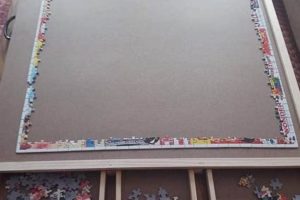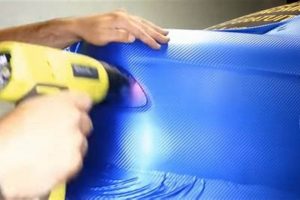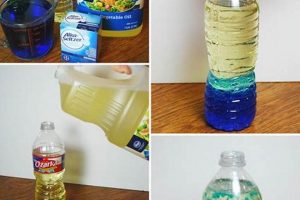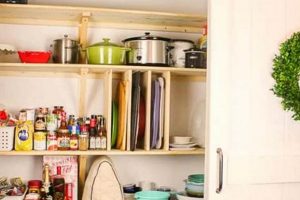The construction of outdoor seating and related items utilizing reclaimed wooden platforms has become a prevalent practice. This approach transforms readily available shipping structures into functional and aesthetically pleasing additions for outdoor spaces. For example, a repurposed platform can be disassembled and rebuilt to create a sofa, table, or chair suitable for patios, gardens, or decks.
This method offers a cost-effective alternative to purchasing new outdoor furniture sets. Utilizing salvaged materials reduces waste and promotes environmentally conscious practices. Historically, repurposing materials for practical use has been a common practice driven by necessity and resourcefulness. The current trend reflects a renewed interest in sustainability and individual expression through handcrafted items.
Subsequent sections will detail the necessary tools and materials, step-by-step construction guides, safety precautions, and finishing techniques associated with crafting outdoor furniture from repurposed platforms. Various design considerations and project examples will also be explored.
Tips for Working with Reclaimed Platform Outdoor Seating
Effective construction and longevity of outdoor seating made from reclaimed platforms necessitate careful planning and execution. The following tips provide guidance for achieving optimal results.
Tip 1: Material Selection: Prioritize platforms designated as HT (Heat Treated) to minimize the risk of chemical contamination. Avoid those marked with MB (Methyl Bromide), a highly toxic fumigant. Inspect each platform thoroughly for damage, rot, and insect infestation prior to use.
Tip 2: Secure Disassembly: Utilize appropriate tools, such as a reciprocating saw or pry bar, to carefully dismantle platforms. Exercise caution to avoid splitting the wood or damaging fasteners. Removal of all nails and staples is crucial for safety and ease of subsequent processing.
Tip 3: Thorough Cleaning: Remove dirt, debris, and any remaining contaminants from the wood surfaces using a stiff brush and a suitable cleaning solution. Power washing, if used, should be conducted with caution to prevent water damage and splintering.
Tip 4: Sanding and Smoothing: Sand all surfaces to create a smooth, splinter-free finish. Progress through various grit levels, starting with a coarse grit to remove imperfections and finishing with a fine grit for a polished surface. Proper sanding enhances both the aesthetic appeal and the user experience.
Tip 5: Protective Finishing: Apply a sealant or stain specifically designed for outdoor use. This protects the wood from moisture, UV radiation, and other environmental factors, extending the lifespan of the furniture. Multiple coats may be necessary for optimal protection.
Tip 6: Joint Reinforcement: Strengthen joints with screws, bolts, and wood glue to enhance structural integrity and stability. Consider using metal brackets or corner braces for added support, particularly in high-stress areas.
Tip 7: Comfortable Seating: Invest in high-quality outdoor cushions and pillows to enhance comfort and usability. Select fabrics that are water-resistant, fade-resistant, and easy to clean. Proper cushioning significantly improves the overall seating experience.
Implementing these suggestions promotes structural soundness, extends the lifespan of the finished product, and ensures safe and comfortable use. Thorough preparation and meticulous execution are key to successful platform furniture construction.
The following sections will delve into specific design ideas and offer detailed construction plans, further equipping the reader to create customized outdoor furniture.
1. Sourcing
The initial phase in constructing outdoor furniture from reclaimed wooden platforms involves sourcing suitable materials. The choice of platforms directly influences the final product’s quality, safety, and aesthetic appeal. Therefore, the sourcing process requires careful consideration of several factors. The type of wood, its prior use, and any treatments applied are all critical determinants. Neglecting this step can result in furniture that is structurally unsound, potentially hazardous due to chemical contamination, or aesthetically unappealing.
Industrial sectors, retail establishments, and construction sites frequently discard platforms. Establishing relationships with these sources can provide a consistent supply of materials. Platforms marked with “HT” (heat-treated) are preferable, as they have undergone a heat treatment process to eliminate pests and are generally considered safer than those treated with chemicals. Conversely, platforms marked with “MB” (methyl bromide) should be avoided due to the toxicity of the fumigant. The physical condition of the platform also matters; those exhibiting significant damage, rot, or insect infestation should be rejected to maintain the project’s integrity.
Ultimately, responsible sourcing forms the foundation of any successful endeavor involving repurposed wooden platforms. Prioritizing safe, structurally sound materials ensures the resulting furniture is both durable and environmentally conscious. Overlooking this critical step can compromise the project’s overall value and potentially introduce safety risks. The subsequent steps in the construction process rely heavily on the quality of the initial materials obtained.
2. Disassembly
The process of disassembly constitutes a critical stage in the creation of outdoor furniture from reclaimed wooden platforms. The structural integrity and overall aesthetic of the final product are directly contingent upon the careful and methodical deconstruction of the platform. Improper disassembly can result in damaged wood, unusable components, and increased safety hazards. For instance, using excessive force when prying apart planks can lead to splitting and splintering, rendering the wood unsuitable for furniture construction. Therefore, employing appropriate tools and techniques is paramount.
Specifically, the use of a reciprocating saw or a specialized platform disassembly tool can significantly reduce the risk of wood damage. Furthermore, the meticulous removal of nails, staples, and other fasteners is essential to prevent injuries during subsequent sanding and assembly processes. A real-world example involves a craftsman who, due to improper nail removal, sustained a puncture wound, highlighting the importance of this seemingly minor detail. Effective disassembly techniques also influence the yield of usable material from each platform. Minimizing waste during this stage contributes to the overall sustainability of the project.
In summary, disassembly is not merely a preliminary step but an integral component of the entire process. Its impact extends from material preservation to user safety. By prioritizing careful technique and employing appropriate tools, builders can max
imize the utility of reclaimed platforms and mitigate potential risks. The effectiveness of this initial step directly correlates with the quality and longevity of the finished outdoor furniture. The skills and diligence applied during platform breakdown influence the success of the entire project.
3. Preparation
Preparation is a foundational element in the successful creation of outdoor furniture from repurposed platforms. Neglecting thorough preparation compromises structural integrity, aesthetic appeal, and user safety, undermining the project’s overall value. Consequently, meticulous planning and execution during the preparation phase are paramount.
- Wood Treatment Assessment
Prior to any modification, assessing the wood’s previous treatment is crucial. Platforms may have undergone heat treatment (HT) or chemical fumigation. Utilizing platforms treated with methyl bromide (MB) poses a significant health risk. Identifying and segregating these materials ensures a safe working environment and a non-toxic finished product. For instance, refusing platforms with unknown or hazardous treatments prevents potential exposure to harmful substances.
- Cleaning and Decontamination
Thorough cleaning removes dirt, grime, and potential contaminants from the wood surface. This step enhances adhesion for subsequent finishes and reduces the risk of introducing allergens or irritants. Pressure washing, scrubbing with appropriate cleaning solutions, and allowing the wood to fully dry are essential. An example is the removal of ingrained dirt from a platform previously used to transport industrial materials, requiring heavy-duty cleaning agents and multiple rinsing cycles.
- Sanding and Smoothing
Sanding creates a smooth, uniform surface, eliminating splinters and sharp edges that could cause injury. It also improves the wood’s receptivity to stains and sealants. Progressing through various grit levels, from coarse to fine, ensures a professional finish. A practical application involves using a belt sander to level uneven surfaces on reclaimed planks, followed by hand-sanding to refine edges and corners.
- Material Measurement and Planning
Accurate measurement and detailed planning are critical for efficient material utilization and structural integrity. Calculating the required dimensions for each component and creating a detailed cutting list minimizes waste and ensures accurate assembly. A real-world scenario involves designing a patio sofa using specific platform dimensions, requiring precise measurements and calculations to ensure proper alignment and stability.
These facets of preparationwood treatment assessment, cleaning, sanding, and planningare inextricably linked to the quality and safety of DIY platform outdoor furniture. The level of attention dedicated to these initial steps directly influences the project’s outcome, determining its durability, aesthetic appeal, and overall success. In essence, diligent preparation lays the groundwork for a rewarding and sustainable construction endeavor.
4. Construction
The construction phase represents the pivotal transformation of raw reclaimed platforms into functional outdoor furniture. Sound construction techniques directly determine the durability, stability, and overall lifespan of the finished piece. Improper joinery, inadequate support structures, or insufficient weatherproofing undermine the integrity of the furniture, rendering it unsuitable for prolonged outdoor use. The choice of construction methods, materials, and hardware must align with the intended design and the anticipated environmental conditions. For example, a platform-based patio sofa intended for heavy use requires reinforced joints, sturdy framing, and weather-resistant fasteners to withstand stress and prevent premature failure. The construction phase is where theoretical designs translate into tangible, usable objects, and therefore, represents a critical juncture in the entire endeavor.
Specific construction methods employed may include screwing, bolting, gluing, and the use of metal brackets for reinforcement. The selection depends on the specific design and load-bearing requirements. For instance, constructing a platform-based coffee table might involve simpler techniques, such as screwing the platform planks together and attaching legs. However, building a more complex structure, such as a multi-tiered planter, necessitates more sophisticated joinery and reinforcement strategies to ensure structural stability and prevent collapse. Furthermore, attention to detail, such as countersinking screws and sanding sharp edges, enhances both the safety and aesthetic appeal of the finished furniture. Real-world examples demonstrate that inadequate construction can lead to structural failures, such as sagging seats, wobbly legs, and premature weathering, necessitating costly repairs or replacements. This highlights the practical significance of adhering to established woodworking principles and employing appropriate construction techniques.
In summary, the construction phase directly impacts the functionality, longevity, and safety of outdoor furniture constructed from repurposed platforms. Adherence to sound woodworking practices, selection of appropriate materials, and meticulous execution are essential for achieving a durable and aesthetically pleasing outcome. The inherent challenges of working with reclaimed materials, such as uneven surfaces and varying wood densities, necessitate careful planning and skilled craftsmanship. Effective construction ensures that the repurposed platforms are transformed into reliable and enjoyable outdoor furniture, extending their useful life and contributing to sustainable practices.
5. Finishing
The finishing stage represents a critical determinant of both the aesthetic appeal and the long-term durability of outdoor furniture crafted from reclaimed wooden platforms. Proper finishing protects the wood from environmental degradation, enhances its visual characteristics, and ensures user safety. The application of appropriate finishes transforms rough, weathered platforms into attractive and functional outdoor pieces.
- Protective Coatings
The primary function of a finish is to protect the wood from moisture, ultraviolet (UV) radiation, and physical abrasion. Exterior-grade sealants, stains, and paints form a barrier against these elements, preventing rot, warping, and fading. For instance, applying a UV-resistant sealant to a platform-based bench shields the wood from sun damage, extending its lifespan and preserving its appearance. Failure to apply a protective coating renders the wood vulnerable to rapid deterioration, necessitating frequent repairs or replacements.
- Aesthetic Enhancement
Finishing allows for customization of the furniture’s appearance, enabling it to complement various outdoor settings. Stains enhance the natural grain of the wood, while paints provide a wider range of color options. For example, staining a platform-based coffee table with a dark walnut finish creates a rustic aesthetic, while painting it a bright color adds a contemporary touch. The selection of appropriate colors and textures
contributes significantly to the overall design and visual appeal of the furniture. - Surface Smoothing and Safety
Finishing processes, such as sanding and sealing, create a smooth, splinter-free surface, minimizing the risk of injury. Applying multiple coats of sealant and lightly sanding between coats creates a durable, even finish that is comfortable to the touch. Real-world applications involve sanding rough edges and filling in cracks with wood filler before applying a final coat of sealant, ensuring user safety and preventing snagging on clothing.
- Preservatives and Insecticides
Certain finishes contain preservatives and insecticides that protect the wood from fungal decay and insect infestation. These treatments are particularly important for outdoor furniture exposed to damp conditions or areas with high insect activity. For example, applying a wood preservative containing copper naphthenate to a platform-based planter box inhibits rot and prevents damage from termites. The use of appropriate preservatives significantly extends the lifespan of the furniture and minimizes maintenance requirements.
The strategic application of appropriate finishes is integral to realizing the full potential of repurposed platform outdoor furniture. Properly selected and applied finishes enhance both the aesthetic value and functional durability, ensuring that these pieces contribute meaningfully to outdoor living spaces. Moreover, effective finishing promotes user safety and extends the useful life of the materials, supporting sustainable practices by minimizing the need for replacements. The finishing process, therefore, is not merely a superficial enhancement but an essential element in the creation of lasting and enjoyable outdoor furniture.
6. Sustainability
The intersection of sustainability and the creation of outdoor furniture from repurposed platforms represents a tangible application of resource conservation principles. The core tenet of sustainability involves minimizing environmental impact through reduced consumption, waste reduction, and responsible resource management. Constructing outdoor seating from reclaimed platforms directly addresses these concerns by diverting discarded materials from landfills and transforming them into functional items. The environmental benefit arises from avoiding the extraction, processing, and transportation of virgin materials required for conventional furniture production. A real-world example involves a community garden project that utilized reclaimed platforms to build benches and planters, significantly reducing its carbon footprint compared to purchasing commercially manufactured alternatives. This action demonstrates a direct link between repurposing discarded materials and mitigating environmental harm.
The importance of sustainability as a component of constructing outdoor furniture from repurposed platforms extends beyond environmental considerations. It also encompasses economic and social dimensions. By utilizing readily available, often free, materials, individuals and communities can create affordable outdoor furnishings, promoting resourcefulness and self-sufficiency. Furthermore, engaging in the construction process fosters skill development and a greater appreciation for the value of materials. For instance, a vocational training program might incorporate the building of platform furniture as a means of teaching carpentry skills while simultaneously emphasizing sustainable practices. Such initiatives demonstrate the potential for repurposed platform furniture to contribute to economic empowerment and social equity.
In summary, constructing outdoor furniture from reclaimed platforms embodies the principles of sustainability by reducing waste, conserving resources, and promoting economic and social benefits. While challenges exist, such as sourcing suitable materials and ensuring structural integrity, the practice offers a compelling alternative to conventional furniture production. The practical significance lies in its potential to transform discarded materials into valuable assets, fostering a more circular and environmentally responsible economy. The broader theme highlights the power of individual and collective action to mitigate environmental impact and promote sustainable living practices through creative repurposing.
Frequently Asked Questions About Platform Outdoor Furniture
The following addresses common inquiries regarding the construction and use of outdoor furniture made from reclaimed wooden platforms.
Question 1: What types of platforms are suitable for furniture construction?
Platforms designated as HT (heat treated) are generally preferred due to the absence of chemical fumigation. Platforms marked MB (methyl bromide) should be avoided due to toxicity concerns. The structural integrity of the platform must also be assessed prior to use.
Question 2: How should platforms be prepared before construction begins?
Platforms must be thoroughly cleaned to remove dirt, debris, and potential contaminants. Sanding is required to create a smooth surface and eliminate splinters. Disassembly should be performed carefully to avoid damaging the wood.
Question 3: What are the essential tools for building platform furniture?
Essential tools include a reciprocating saw or platform disassembly tool, a drill, a sander, measuring tools, and appropriate safety equipment, such as gloves and eye protection.
Question 4: What types of finishes are recommended for outdoor platform furniture?
Exterior-grade sealants, stains, and paints are recommended to protect the wood from moisture, UV radiation, and physical abrasion. Finishes containing preservatives and insecticides can further enhance durability.
Question 5: How can the structural integrity of platform furniture be ensured?
Reinforcement with screws, bolts, and metal brackets is recommended, particularly in high-stress areas. Careful planning and precise execution of joinery techniques are also essential.
Question 6: What are the key safety considerations when working with reclaimed platforms?
Prioritize the use of heat-treated platforms and avoid those treated with methyl bromide. Wear appropriate safety gear, including gloves, eye protection, and a dust mask. Ensure a well-ventilated workspace to minimize exposure to dust and fumes.
Proper material selection, thorough preparation, sound construction techniques, and appropriate finishing are crucial for creating durable and safe outdoor furniture from reclaimed platforms.
Subsequent sections will explore advanced design concepts and customization options.
diy pallet patio furniture
The preceding exploration has illuminated various facets of outdoor furniture construction utilizing reclaimed wooden platforms. The information presented underscores the significance of material sourcing, preparation, construction methodologies, and finishing techniques in achieving durable, aesthetically pleasing, and safe outdoor furnishings. It highlights that careful planning and execution are crucial for maximizing the potential of repurposed materials.
Given the increasing emphasis on sustainable practices and resource conservation, the adoption of methodologies involving reclaimed materials holds significant potential. Successful implementation requires adherence to safety guidelines, a commitment to quality craftsmanship, and a comprehensive understanding of the principles outlined herein. This approach presents a viable
alternative to conventional furniture production, offering both environmental and economic benefits.







